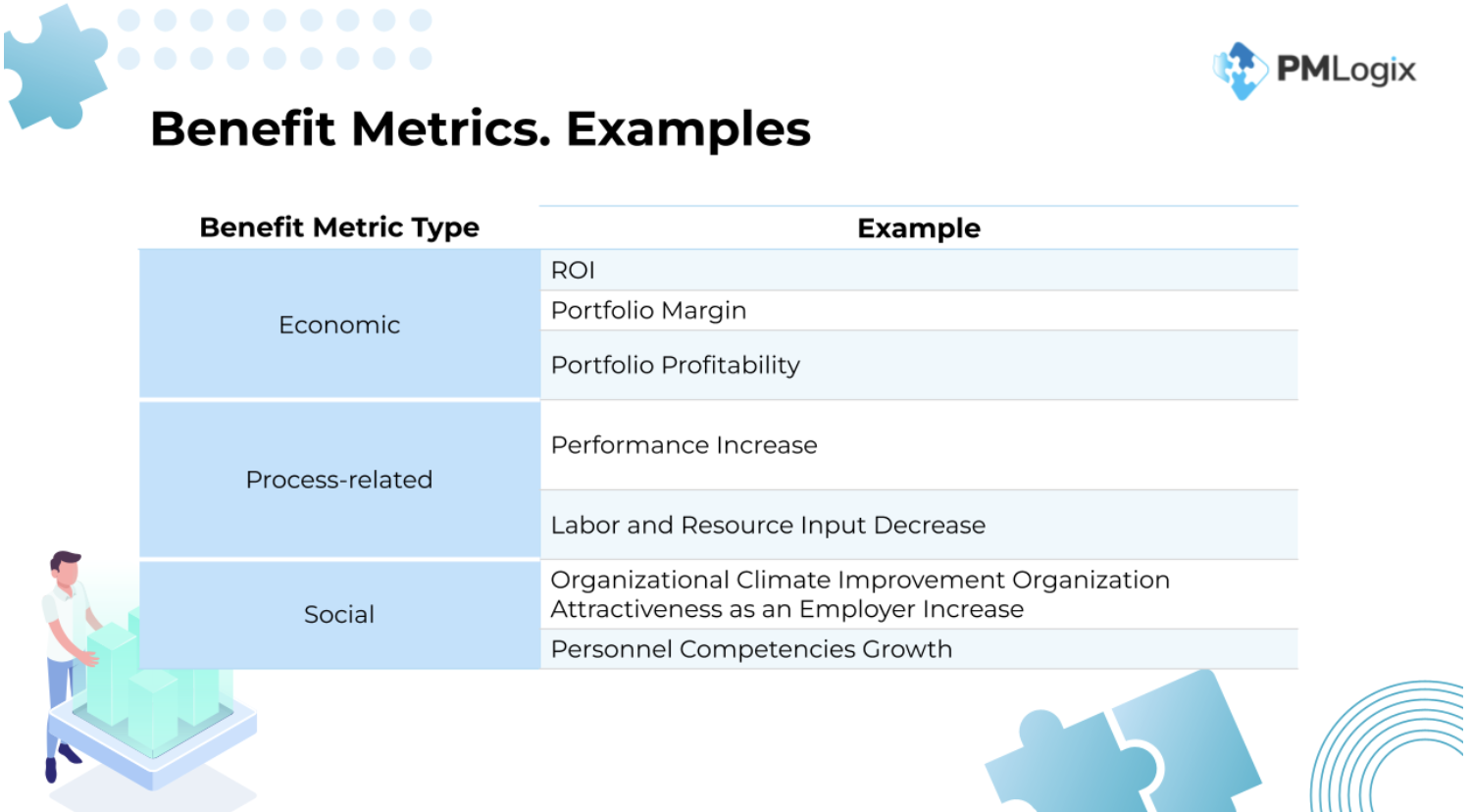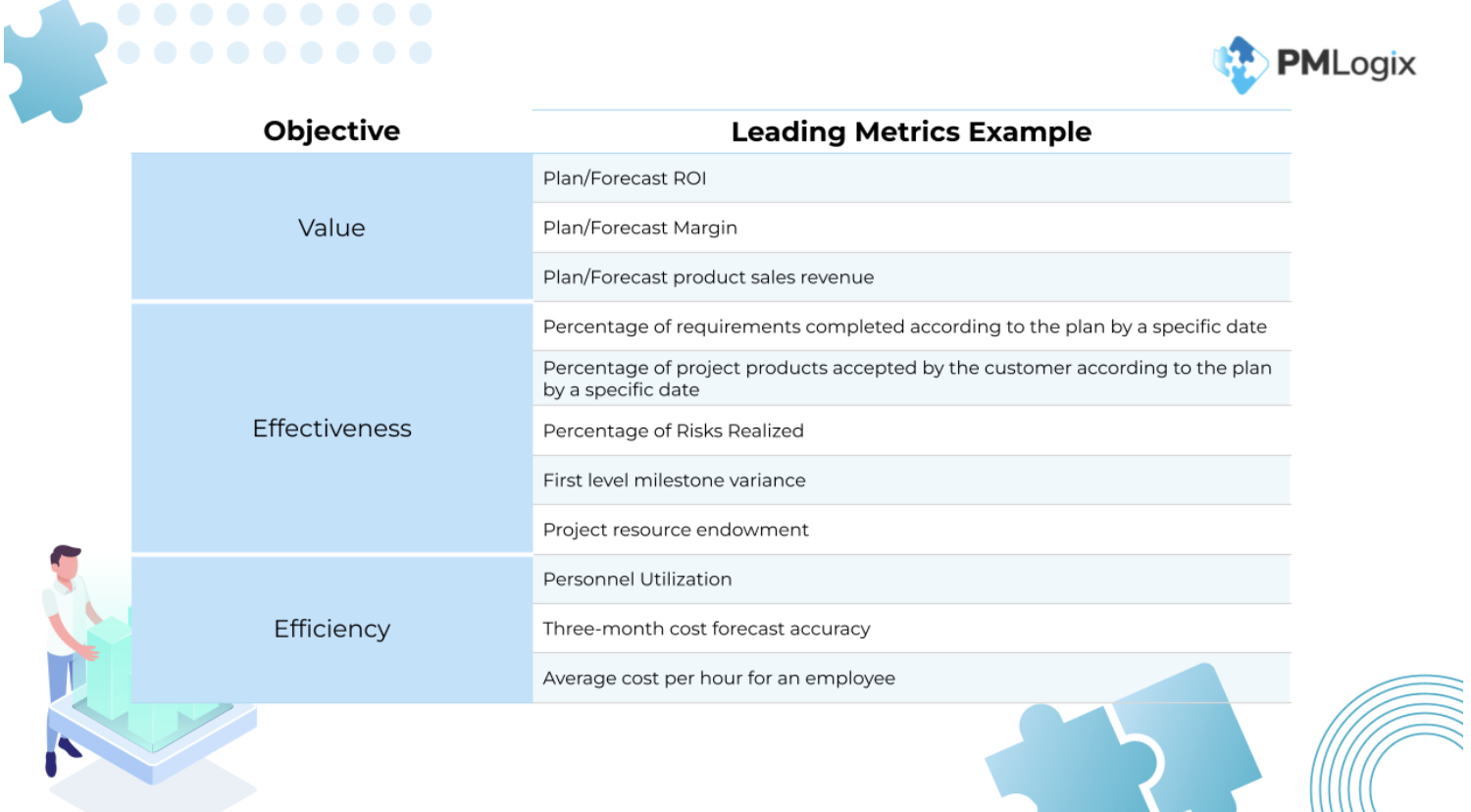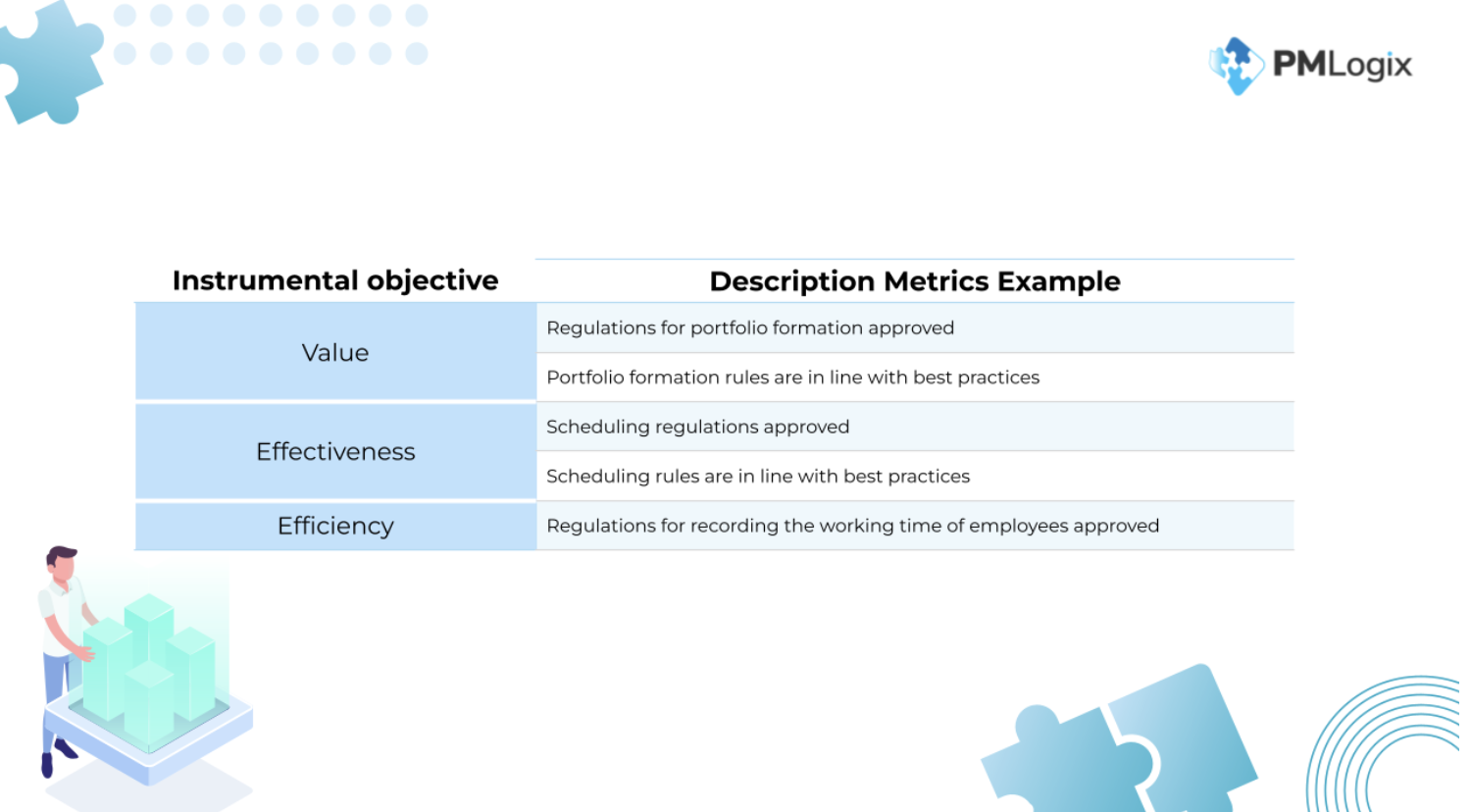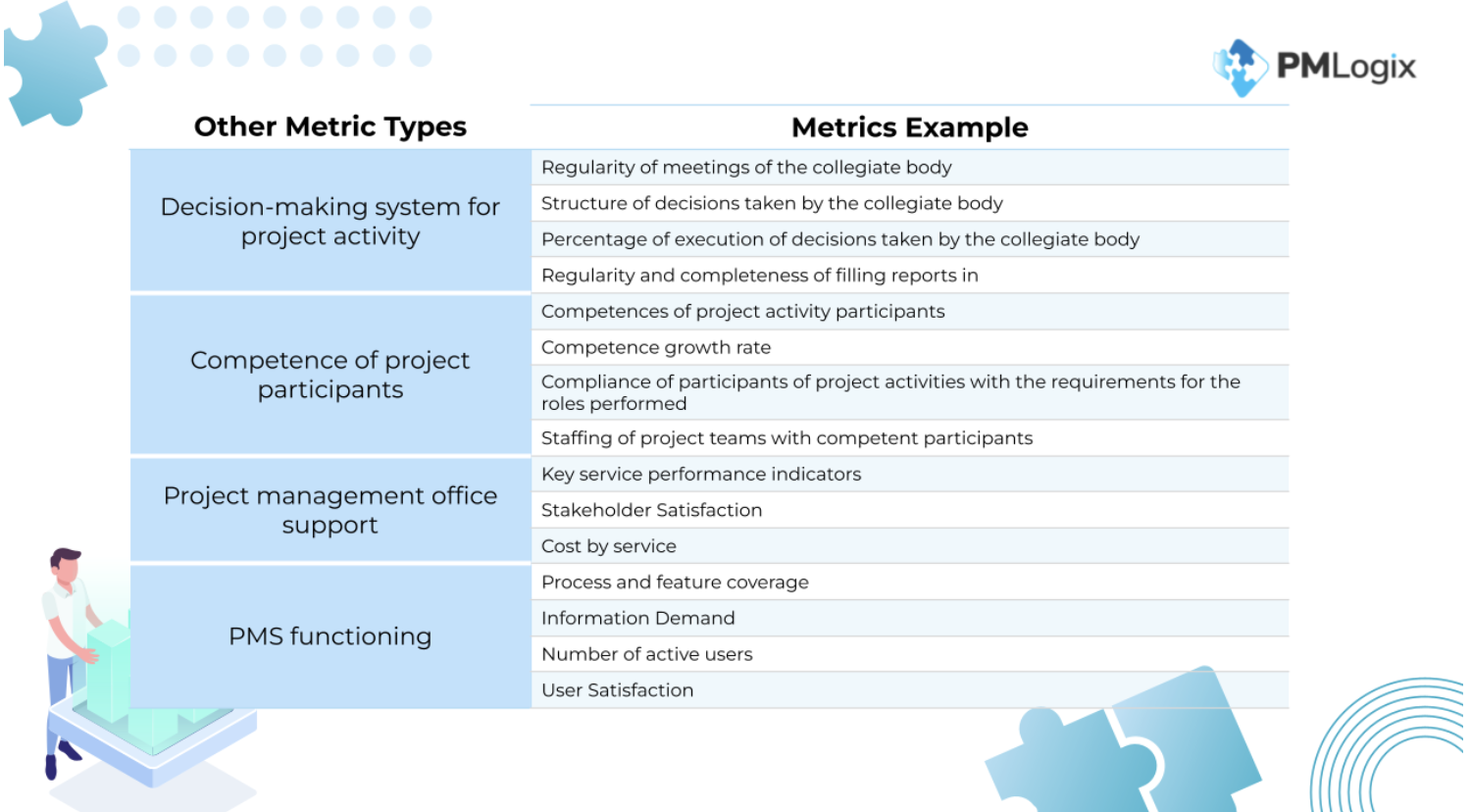How to Measure Organizational Project Management?

-
Business Owners
-
Head of PMO
-
Project managers
-
Project Activity Sponsor
-
PMO Setup
-
Project Management
-
Change Management
-
Monitoring&Reporting
-
IT-Project Management
- 8 min
In a modern organization, it is impossible to manage programs, projects, and all project activities in general, blindly without the necessary information. The basis for forming such information can be a system of metrics that describes all areas of Organizational Project Management (hereafter — OPM) and consists of three groups: results metrics, project maturity metrics, and other organizational project management functioning metrics. In this article, we will talk about all of these groups.
Metric — an indicator that determines whether the goal is achieved.
OPM metrics are necessary to assess the achievement of OPM goals. Let’s take a closer look at them.
Organizational Project Management Goal
The main OPM goal is to achieve strategic goals and realize expected benefits by means of project portfolio execution.
Projects and program portfolios are used to create new or change existing products, processes, and procedures according to the organization’s strategic goals. Therefore, the main metrics for evaluating OPM are often the metrics of benefits — the benefits realized by the organization from the execution of certain programs and projects.
Benefit metrics are used to evaluate OPM performance.
For OPM in general, both effects and costs are essential, which are considered in total for all implemented portfolios. In addition, it is necessary to consider the costs of OPM, including the management of certain projects and programs.
Instrumental objectives determine the vectors for improving OPM to achieve the main goal successfully. Instrumental objectives ensure the achievement of the main goal and the achievement of the target values of the benefit metrics. Therefore, all metrics, except the benefit metrics, are considered in the context of one of the instrumental objectives.
There are three instrumental goals of project activities:
- Maximization of value is associated with the selection of programs and projects in the portfolio that bring the greatest benefit to the strategic goals of the organization. This objective is achieved through the implementation of the processes of Program and Portfolio management.
The composition of specific metrics for this objective depends on the strategic goals and values of the organization since the purpose of the metrics is to evaluate the contribution of programs and portfolio projects to their achievement. However, it is important to go beyond economic metrics, as, from an organization’s strategy perspective, building assets and infrastructure can be more critical than making short-term profits.
- Achieving effectiveness is associated with obtaining results within the specified constraints (time, resources) and is aimed at reducing the impact of risks. Effectiveness is ensured through the processes and tools for managing individual programs and projects, particularly planning, organization, communication, and monitoring. The composition of the metrics for the objective depends on the specifics of the programs and projects being executed. For example, the schedule tolerance will depend on the expectations of external stakeholders (linked to the announced release date).
- Ensuring efficiency is associated with the optimal use of resources (mainly human, financial, and material) within the portfolio and is ensured through the processes of planning, accounting, and balancing. The metrics for this objective measure the use of resources compared to the effects obtained, similar projects in the organization (or in other similar organizations). The company’s management strives to minimize redundant reservation of resources within a particular program or project in favor of reallocation to those programs and projects that really need them. Therefore, efficiency also means identifying and reducing the amount of reserved but unused resources.
And now, let’s take a closer look at the classification of the OPM metrics.
OPM metrics
1. Outcome Metrics
Outcome metrics measure the final and intermediate results of a portfolio, programs, and projects. They serve to select the optimal composition of the portfolio and evaluate the results of the implementation of programs and projects that provide the planned results. Most of these metrics are used by senior management as indicators of the project/program’s success. They are relevant for almost any organization that is engaged in the implementation of projects.
Also, even though all outcome metrics are used to evaluate individual programs and projects, their main task is to balance the organization’s portfolio and optimize the costs of project activities. For example, using the ROI metric, you can evaluate the effects of an individual project. But without considering the structure and the total sum of the portfolio effects, the organization’s strategic development plans, it is impossible to understand whether it is advisable to include this project in the portfolio.
ROI — Return on Investment
The group of outcome metrics is divided into three subgroups: benefit metrics, result, and forecast metrics.
- Benefit Metrics
Benefit metrics are used to measure the dynamics of the OPM after the completion of the implementation of the programs and projects portfolio.
The most common type of benefit metric is economic, but other quantitative and qualitative metrics can also be used.
Portfolio Margin — cumulative margin of individual projects in the portfolio.
Portfolio Profitability — cumulative profitability of projects (usually commercial).
Benefit metrics are one of the most difficult to relate to OPM performance, as they are influenced not only by the programs and projects being implemented but also by other internal and external factors. For example, the value of the revenue metric for the sale of a new product will depend on the current market situation, to say nothing about the quality of the product and the time it will be launched to the market.
In addition, due to limited resources, organizations are forced to balance the composition of programs and projects so that the cost of projects that create non-economic effects is offset by the income or cost reduction from projects that bring economic benefits.
1.2. Result Metrics
The result metrics measure the parameters of success in the implementation of the portfolio, the completion of the program, and the project or their part (stage). As well as forecast metrics and maturity metrics, they are divided into groups according to the type of instrumental objective.
For the goal of “Achieving effectiveness” in the resulting metrics, it is possible to highlight the indicators of the portfolio projects’ products and compliance with constraints (in terms of time, budget, resources, and others).
The result metrics are used to make decisions about starting, stopping, closing, or terminating individual programs and projects in the portfolio to maximize the cumulative effects while making the best use of resources. For example, a particular project may be terminated early due to low payback (value factors), poor product quality, and significant time or budget overruns (effectiveness factors), allowing resources to be reallocated to more promising projects. However, despite this, the project implementation can be continued if the project results impact the effects of other programs and portfolio projects.
A significant drawback of the result metrics is that they are known at the end of the execution of a program, project, or stage. Therefore, they most often do not prevent a negative result in the current project but can be helpful if we want not to let a negative scenario happen again in the future.
1.3. Leading Metrics
Leading metrics aim to eliminate the drawbacks of result metrics, which we discussed in the previous paragraph. With their help, you can predict the portfolio, program, or project performance indicators without waiting for the end of the project. Therefore, each result metric will correspond to one or more leading metrics.
Leading metrics are needed to ensure the timely implementation of corrective actions, so their use is based on high-quality and sufficiently detailed plans. For example, for the target value “Number of projects completed on time” for each project, you need to track the leading metric “Percentage of intermediate milestones completed on time.” To do this, it is necessary to define milestones that allow you to assess compliance with the deadlines for the implementation of all critical work and the receipt of intermediate results. At the same time, milestones should reflect critical stages for meeting deadlines and be evenly distributed over the entire timeline of the project; otherwise, this metric will be useless.
In addition to the quality of planning, the use of leading metrics is influenced by the presence of an information system for project activities in the organization. In the absence of such a system, the labor intensity of regular monitoring of leading metrics will be too high and will most likely require the allocation of responsible employees. In addition, the quality and timeliness of data provision may suffer.
The use of a large number of leading metrics in the absence of an information system can also lead to an increase in the complexity of project administration. Therefore, when determining the composition of leading metrics, it is necessary to choose the really important indicators that influence the decision-making process, predict possible problems, and are easily collected from available sources and information systems.
2. Maturity Metrics
OPM maturity metrics evaluate the existence of a single, optimal approach for the organization to the OPM and assess its use in practice. These metrics are used to determine the areas of project improvement and are often not tracked in organizations where project management offices are not interested in evaluating their own performance objectively.
A significant difficulty for maturity assessment is the choice or development of a relevant maturity assessment model and its adaptation to the needs of a particular organization.
2.1. Description Metrics
The metrics describing OPM’s way of working and practices allow us to assess the existence of unified approved standards for OPM in an organization. They also determine the existence of a documented methodology for projects, programs, and portfolios. If the methodology is not described, each project manager is likely to manage in his own way, that is, solely based on his experience and knowledge. In addition, transferring the company’s current practices to paper, although not self-sufficient, leads to a situation when all parties have a better understanding of the company’s way of organizing work and mandatory and optional requirements.
The described and approved project methodology provides the basis for the unification of the composition and essence of the necessary actions for all projects. At the same time, there is a risk of being out-of-date and redundancy of requirements, which leads to bureaucratization, a decrease in the speed of project implementation, and a refocusing of project managers from achieving results to following procedures. Therefore, description metrics should include only those practices and procedures that significantly affect the achievement of instrumental goals.
For example, for an IT system integrator implementing projects for external customers, the regularity and quality of communication with the customer will become essential parameters. Describing this process will reduce the risk of customer dissatisfaction. At the same time, for a small organization delivering internal projects, the description of this process is rather redundant since this area does not generate significant risks.
2.2. Application Metrics
Project methodology application metrics allow you to assess how effectively certain approaches and practices are used in real projects. The best way to evaluate is to check management documents and follow up.
At the same time, metrics can be focused on identifying different levels of maturity, for example: “I know, but I don’t apply,” “I apply formally,” or “I apply with maximum quality and effects.”
The process of measuring the indicators of the application of the methodology involves checking the availability of documents or other artifacts confirming the implementation of the necessary management processes, meetings, or other described procedures. The cost and labor intensity of the process do not allow us to use it largely and regularly for projects.
However, the mere presence of a document, as in the example with a detailed plan for milestones, does not guarantee the elimination of the risks of non-fulfillment of indicators. Therefore, along with the metrics of actual application, we use metrics of quality and depth of application, for example: “Quality of filling templates in,” “Regularity of updating data,” “Comprehensiveness of the decision-making body members list,” and “Participation of members of the body in meetings.” Such a check requires a fairly serious examination by the inspectors. Moreover, most of it cannot be automated, which leads to its high labor intensity and cost.
Maturity metrics are insidious, as attempts to put them at the forefront (“We need to raise the maturity level from 3 to 5”), to define them as an annual target, and at the same time decouple them from the benefit and result metrics usually lead to the creation of unnecessary procedures that are required to be fulfilled rigorously. This is a dead-end path. These metrics can serve as an addition to the benefit and result metrics.
3. Other Metrics of the OPM Functioning
Other types of metrics include indicators that are outside the scope of the direct implementation of programs and projects but which, however, just like the project management methodology, create the necessary conditions for their successful selection and implementation.
So, to establish a full-fledged OPM in an organization, it is crucial to use a modern metrics system. That is, it is necessary to learn how to evaluate the indicators of benefits and results comprehensively. To prevent problems promptly, it is helpful to use forecasting metrics that require high-quality planning and the use of an automated project management system (PMS). Maturity metrics, including description and application metrics, are preferably evaluated by independent external experts. It is important to remember that they are not self-sufficient but should be assessed in conjunction with benefit and result metrics.
Other metrics, including an assessment of the project management office, the functioning of the PMS, the competence of the project activity participants, and the governance functioning, can identify stop factors, without which it is difficult to count on the success of the OPM as a whole.

You have successfully subscribed to the newsletter
Check your email
An error occurred while sending. Try again
Comment has been successfully sent
An error occurred while sending. Try again









